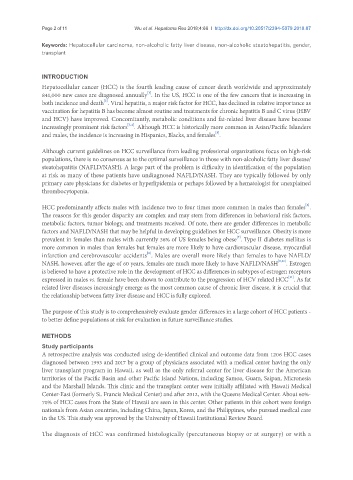Page 737 - Read Online
P. 737
Page 2 of 11 Wu et al. Hepatoma Res 2018;4:66 I http://dx.doi.org/10.20517/2394-5079.2018.87
Keywords: Hepatocellular carcinoma, non-alcoholic fatty liver disease, non-alcoholic steatohepatitis, gender,
transplant
INTRODUCTION
Hepatocellular cancer (HCC) is the fourth leading cause of cancer death worldwide and approximately
[1]
841,000 new cases are diagnosed annually . In the US, HCC is one of the few cancers that is increasing in
[2]
both incidence and death . Viral hepatitis, a major risk factor for HCC, has declined in relative importance as
vaccination for hepatitis B has become almost routine and treatments for chronic hepatitis B and C virus (HBV
and HCV) have improved. Concomitantly, metabolic conditions and fat-related liver disease have become
[3,4]
increasingly prominent risk factors . Although HCC is historically more common in Asian/Pacific Islanders
[5]
and males, the incidence is increasing in Hispanics, Blacks, and females .
Although current guidelines on HCC surveillance from leading professional organizations focus on high-risk
populations, there is no consensus as to the optimal surveillance in those with non-alcoholic fatty liver disease/
steatohepatitis (NAFLD/NASH). A large part of the problem is difficulty in identification of the population
at risk as many of these patients have undiagnosed NAFLD/NASH. They are typically followed by only
primary care physicians for diabetes or hyperlipidemia or perhaps followed by a hematologist for unexplained
thrombocytopenia.
[6]
HCC predominantly affects males with incidence two to four times more common in males than females .
The reasons for this gender disparity are complex and may stem from differences in behavioral risk factors,
metabolic factors, tumor biology, and treatments received. Of note, there are gender differences in metabolic
factors and NAFLD/NASH that may be helpful in developing guidelines for HCC surveillance. Obesity is more
[7]
prevalent in females than males with currently 38% of US females being obese . Type II diabetes mellitus is
more common in males than females but females are more likely to have cardiovascular disease, myocardial
[8]
infarction and cerebrovascular accidents . Males are overall more likely than females to have NAFLD/
NASH, however, after the age of 60 years, females are much more likely to have NAFLD/NASH [9,10] . Estrogen
is believed to have a protective role in the development of HCC as differences in subtypes of estrogen receptors
[11]
expressed in males vs. female have been shown to contribute to the progression of HCV related HCC . As fat
related liver diseases increasingly emerge as the most common cause of chronic liver disease, it is crucial that
the relationship between fatty liver disease and HCC is fully explored.
The purpose of this study is to comprehensively evaluate gender differences in a large cohort of HCC patients -
to better define populations at risk for evaluation in future surveillance studies.
METHODS
Study participants
A retrospective analysis was conducted using de-identified clinical and outcome data from 1206 HCC cases
diagnosed between 1993 and 2017 by a group of physicians associated with a medical center having the only
liver transplant program in Hawaii, as well as the only referral center for liver disease for the American
territories of the Pacific Basin and other Pacific Island Nations, including Samoa, Guam, Saipan, Micronesia
and the Marshall Islands. This clinic and the transplant center were initially affiliated with Hawaii Medical
Center-East (formerly St. Francis Medical Center) and after 2012, with the Queens Medical Center. About 60%-
70% of HCC cases from the State of Hawaii are seen in this center. Other patients in this cohort were foreign
nationals from Asian countries, including China, Japan, Korea, and the Philippines, who pursued medical care
in the US. This study was approved by the University of Hawaii Institutional Review Board.
The diagnosis of HCC was confirmed histologically (percutaneous biopsy or at surgery) or with a

